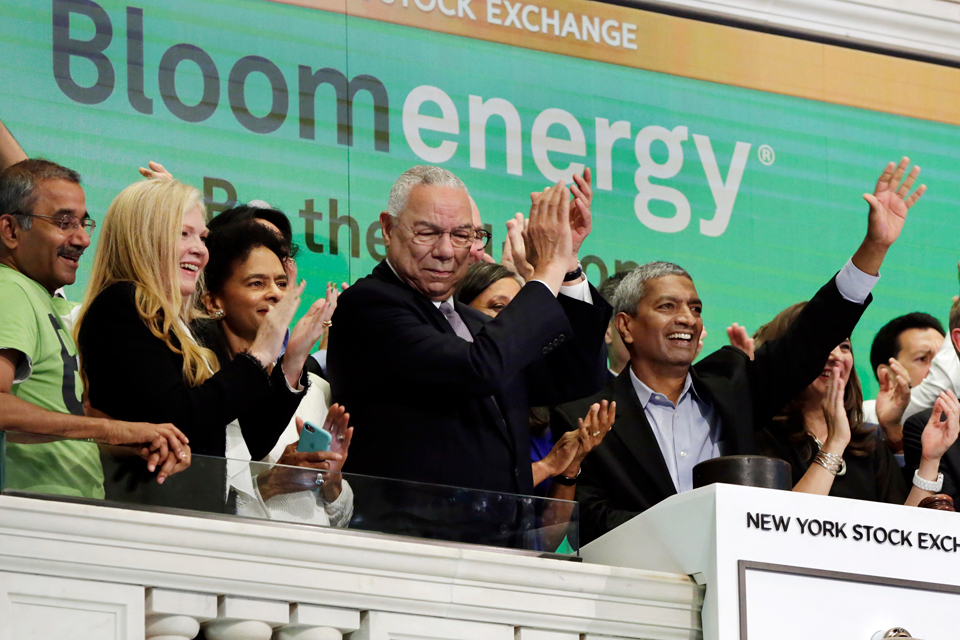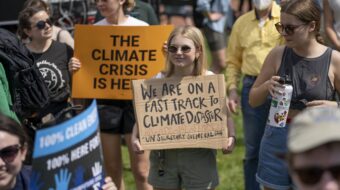
This is Part 1 of a two-part series. Read Part 2 here.
Sen. Bernie Sanders recently tweeted, “A Green New Deal is not radical or extreme. What’s radical and extreme is allowing fossil fuel companies to cause the displacement and deaths of millions of people in order to turn a profit.”
The Vermont senator’s tweet encapsulates the urgency of making the Green New Deal a reality as well as underscoring the dangers it faces from a system based on waste, greed, and exploitation—capitalism. Although Rep. Alexandria Ocasio-Cortez’s 14-point resolution has set out an ambitious program for change, with only one piece of proposed legislation drafted, there is much to be done among labor, community groups, and environmental organizations to prepare for the struggle ahead.
In this two-part article, we will explore the five major policy areas targeted by the Green New Deal resolution and analyze the threats and opportunities each hold for improving the day-to-day lives of working people in the U.S. and beyond.
Profiting off the Green New Deal…if they can’t kill it
The profit motive and its champions in Congress are eager to destroy or, at the least, co-opt the movement for a Green New Deal. As early as February this year, the Union Bank of Switzerland (UBS) issued a report for investors which detailed ways in which they can either oppose or benefit from a Green New Deal.
The report claims, “For many investors, the proposals put forth by the Green New Deal represent a source of uncertainty. For investors who are politically opposed to such a measure, or whose financial interests would be particularly threatened by these proposals, one solution is to invest in environmentally oriented sustainable investments,” says UBS Chief Investment Office strategist Justin Waring.
“In addition to tapping into the themes’ return potential, such an investment also represents a type of ‘hedge’ against the possibility of more-aggressive environmental legislation. It may seem counterintuitive, but if you are worried about environmental legislation, you might want to invest in environmentally-friendly investments.”

From this statement, it’s clear that the capitalist strategy is to invest—not in what is a priority for bettering the lives of ordinary people—but in projects that will fill and protect the bulging pockets of wealthy investors. If they can’t kill the momentum toward a Green New Deal, then, at minimum, they want to reshape it in their own financial interests.
To offset this danger, an alliance of labor, environmental, and social justice organizations is beginning to coalesce and strategize. For this movement to achieve Green New Deal goals, it will need to transform itself through education, the development of class consciousness, and the formation of a disciplined political approach that, like capital itself, transcends national boundaries.
Relying on status quo politics and elected representatives alone cannot make the deep social and environmental changes necessary to build the ecological civilization called for in the Green New Deal. The real empowerment of communities around the U.S. and everywhere else is what’s required. Such a move is mentioned in the new Green New Deal for Public Housing Act sponsored by Sanders and Ocasio-Cortez, which, among many other important objectives, calls for the establishment of resident councils to become dynamic and democratic decision-making bodies for public housing communities.
Five goals, five dangers
The five main Green New Deal policy objectives are intricately interwoven and therefore they must be addressed and realized with great care. These broad points include:
-
1.) net-zero greenhouse gas emissions;
-
2.) the creation of good, high-wage jobs that ensure prosperity and economic security;
-
3.) investment in the infrastructure and industry of the United States;
-
4.) to secure clean air and water, climate and community resiliency, healthy food, access to nature, and a sustainable environment, and finally,
-
5.) to promote justice and equity by stopping current, preventing future, and repairing historic oppression of indigenous peoples, communities of color, migrant communities, de-industrialized communities, depopulated rural communities, the poor, low-income workers, women, the elderly, the unhoused, people with disabilities, and youth.
Each one of these goals will be mercilessly attacked by Green New Deal opponents, but it is equally important to remember that the overarching danger to Green New Deal goals is embedded in U.S. institutions both public and private.
Greenhouse gas emissions
The U.S. Environmental Protection Agency estimates that in 2017 transportation spewed 28.9% of total CO2 emissions nationwide, with electricity generation close behind at 28%. Another 22% came from industry, 12% from residential and commercial energy use, and 9% from agriculture.
However, agriculture’s 9% includes only actual food production, it does not account for the incredibly wasteful supply chain that feeds the country, meaning that a good chunk of transportation’s 28.9% actually belongs to the distribution of foodstuffs. According to recent research led by the University of Illinois at Urbana-Champaign, pulling data from the Freight Analysis Framework from Oak Ridge National Laboratory, which tracks where items are shipped around the country, and Port Trade data from the U.S. Census Bureau, our food travels through 9.5 million links before reaching our tables. Combination U.S. truck fuel consumption alone sucked up over three billion gallons of petroleum in 2017, getting an average of 6 miles to the gallon.

Food production, transportation, and consumption represent between 20 and 29%of all carbon dioxide emissions worldwide. A 2018 report by the American Association for the Advancement of Science indicates that one-quarter of all CO2 emissions globally come from the world’s antiquated, for-profit food supply chain. There are still other considerations that touch on Green New Deal goals which must be addressed, such as the harm industrialized food systems have had on ecosystems and human health.
Confronting the issues of ecological destruction, food security, health, and land reform is necessary to meet Green New Deal goals. One possible key the Green New Deal coalition could use to unlock this conundrum is the encouragement of ecological agriculture, which can help working-class communities develop solutions to extremely difficult problems. But the implementation of ecological agriculture requires land reform, which in turn demands cooperative approaches. It also requires deliberate, sustained social support to meet a wide range of human needs on a national and ultimately international scale.
The Green New Deal can begin this process, but to carry out the entire project will require discipline, unity, and focus. In the long term, the solution must come from the establishment of a cooperative economy which is controlled democratically.
Part 2 will appear in tomorrow’s edition of People’s World.












Comments